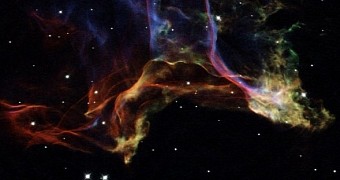About five to ten millennia ago, a distant star reached the end of its life and exploded in a supernova. When this happened, our ancestors here on Earth got to see a huge ball of light shining high up in the sky for a couple of days.
These days, it's almost impossible to tell that this star even existed. In its place sits the Veil Nebula, which was created when the celestial body went boom and which is essentially a huge mass of stellar remains intertwined with cosmic gas and dust.
Some time ago, in July 2007, the Hubble Space Telescope delivered a stunning image revealing a fragment of the Veil Nebula known as the southeastern knot. The image, available next to this article, was revisited by ESA astronomers this past Monday.
The nebula owes its odd and rather hectic appearance to the insanely powerful shock waves that were produced when the star that birthed it exploded. Thus, the twists and turns are essentially gas and dust modeled by the blast in the most bizarre of shapes.
The Veil Nebula was first documented by astronomer William Herschel back in 1784. It sits at a distance of roughly 1,500 light-years from our planet and astronomers estimate that it measures about 50 light-years across at its widest point.

 14 DAY TRIAL //
14 DAY TRIAL //